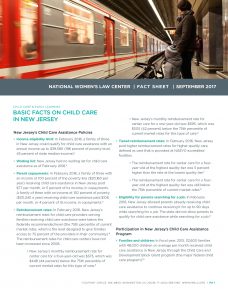Abortion rights, women of color, and LGBTQIA+ people are under attack. Pledge to join us in fighting for gender justice.
 New Jersey’s Child Care Assistance Policies
New Jersey’s Child Care Assistance Policies
- Income eligibility limit: In February 2016, a family of three in New Jersey could qualify for child care assistance with an annual income up to $39,580 (196 percent of poverty level, 45 percent of state median income).
- Waiting list: New Jersey had no waiting list for child care assistance as of February 2016.
- Parent copayments: In February 2016, a family of three with an income at 100 percent of the poverty line ($20,160 per year) receiving child care assistance in New Jersey paid $77 per month, or 5 percent of its income, in copayments. A family of three with an income at 150 percent of poverty ($30,240 a year) receiving child care assistance paid $106 per month, or 4 percent of its income, in copayments.
- Reimbursement rates: In February 2016, New Jersey’s reimbursement rates for child care providers serving families receiving child care assistance were below the federally recommended level (the 75th percentile of current market rates, which is the level designed to give families access to 75 percent of the providers in their community). The reimbursement rates for child care centers have not been increased since 2008.
- New Jersey’s monthly reimbursement rate for center care for a four-year-old was $573, which was $448 (44 percent) below the 75th percentile of current market rates for this type of care.
- New Jersey’s monthly reimbursement rate for center care for a one-year-old was $695, which was $505 (42 percent) below the 75th percentile of current market rates for this type of care.
- Tiered reimbursement rates: In February 2016, New Jersey paid higher reimbursement rates for higher-quality care, defined as care that is provided at NAEYC-accredited facilities.
- The reimbursement rate for center care for a four-year-old at the highest quality tier was 5 percent higher than the rate at the lowest quality tier.
- The reimbursement rate for center care for a four-year-old at the highest quality tier was still below the 75th percentile of current market rates.
- Eligibility for parents searching for a job: In February 2016, New Jersey allowed parents already receiving child care assistance to continue receiving it for up to 90 days while searching for a job. The state did not allow parents to qualify for child care assistance while searching for a job.
Participation in New Jersey’s Child Care Assistance Program
- Families and children: In fiscal year, 2015, 32,600 families with 48,000 children on average per month received child care assistance in New Jersey through the Child Care and Development Block Grant program (the major federal child care program).
- Licensed and regulated child care providers: In fiscal year 2015, 97 percent of children receiving child care assistance in New Jersey were cared for by licensed or regulated providers, including 90 percent that received care in a child care center and 7 percent that received care in a family child care home.
- Child care providers legally operating without regulation: In fiscal year 2015, 2.3 percent of children receiving child care assistance in New Jersey were cared for by legally exempt providers, including 0.4 percent in the child’s home (0.3 percent by relatives and 0.2 percent by non-relatives) and 1.8 percent in a family child care home (0.8 percent by relatives and 1.1 percent by non-relatives).
Child Care Needs of Mothers in Low-Wage Jobs
- Of working mothers with very young children in New Jersey, 13.4 percent are employed in low-wage occupations. Low-wage jobs often entail evening, night, weekend, and variable hours, so these mothers frequently struggle to find child care options flexible enough to accommodate their work schedules.
Average Cost of Child Care in New Jersey
Average annual cost of infant care in 2016:
- Center-based care: $11,548
- Family child care: $8,709
Average annual cost of care for a four-year-old in 2016:
- Center-based care: $9,557
- Family child care: $7,799
